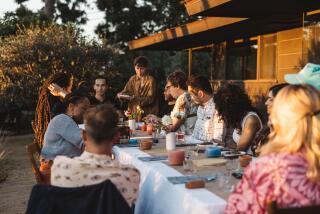Women’s Clubs Cling to Tradition : * Society: The ranks are dwindling, ‘but as long as women find a cluster of companions who are congenial, they’ll find it’s worth the trouble of getting to a meeting.’
It was an era in which daughters were not raised, they were trained-- trained in the ways of lavish cotillions and genteel afternoons spent lifting bone china with gloved hands. Mothers living in the first half of the century were careful to impart an old adage: Men were men, and women were, well, ladies.
And in some pockets of society, women retain the title with pride.
They still gather at a bastion from an earlier era--women’s clubs. Today, about 25 clubs operate in the San Fernando Valley, roughly the same number that existed 30 years ago. But as an aging membership dwindles, clubhouses are increasingly rented out to pay the bills.
“Through the years, every club has lost a lot of members because of girls who started working,” said Betty Franklin, past president of the Sylmar Woman’s Club, which began as a sewing circle in 1940 and has 100 members today. “Members keep growing older, and so you lose a few here and there. The oldest member we have is 75, but many clubs have members who are into their 90s.”
Most women declined to give their age for this story.
The largest network of clubs, the General Federation of Women’s Clubs, created in 1890, has seen its U. S. membership more than halved, dropping from 1 million in 1957 to 350,000 today. Valley chapters include those in Agoura, Westlake Village, Calabasas, Woodland Hills, Canoga Park, Chatsworth, Sepulveda, Van Nuys (the oldest, formed in 1912), Panorama City, Pacoima, Burbank, Sherman Oaks, Tarzana and Granada Hills.
Like many other Valley chapters, the Canoga Park chapter, formed in 1914, reached a membership peak in the 1950s, topping off at about 350 members. Today, chapter memberships range from 10 to 150.
Several GFWC junior chapters serve younger women, ages 18 to 42.
“I joined because I was attracted to the friendship of women in the club. It seemed like something I needed,” said Bo Barkes, 28, president of the Woodland Hills Junior Women’s Club, formed in 1956.
Junior clubs meet evenings to accommodate working members; general clubs meet during the day, usually once a month. A few general clubs retain a tried-and-true formula--four monthly meetings that focus on either the cultural arts, home and garden, literature or bridge.
Barkes’ club nearly died out 10 years ago, with membership plummeting to just three women, but today 15 women run charity drives, organize spelling bees, operate baby-sitting clinics and, at honorary luncheons, feed firefighters the club’s specialty, lasagna.
“Juniors take on a lot more hands-on projects than the general clubs,” said Betty Paravato, the district’s junior club coordinator. “Belonging helps increase independence and self-confidence. These women have a chance to build leadership qualities.”
The profile of women who join such clubs, whether young or old, brings the phrase “stable stock” to the mind of Dorothea Heitz, who joined the Woodland Hills Women’s Club in 1953.
“We’re the end of the Old School,” said Heitz, 75, whose club has about 100 members. “We represent the very tail-end of our mothers’ training and tradition. And our mothers represented the tail-end of the Victorian era. We believe in manners, good language and high values. We were always taught to help others.”
Club members typically have ample leisure time, said Karen Blair, associate history professor at Central Washington University and author of “The Clubwoman as Feminist.”
“Today, once women have left their outside job for the day, have taken care of the house and attended to their family’s needs, they need a nap,” Blair said. “Women aren’t turning to voluntary organizations the way they used to.”
Women’s clubs flourished after the turn of the century as members pitched in as social reformers, building libraries and schools and campaigning for child labor laws, hot school lunches, temperance and universal suffrage. Today, most clubs donate money to local concerns, such as homes for battered women.
Behind a worn card table at a recent Sherman Oaks Women’s Club meeting, literature moderator Lucille Van Bogaert held forth, revealing assorted details of recent novels she has read. The 40 women in attendance, most of them in their 70s and bundled in wool sweaters, paid rapt attention, jotting notes and murmuring with surprise as Van Bogaert told of “The Silence of the Lambs,” a “shocking new film” based on a book she once reviewed for the club.
As Van Bogaert related the film’s gruesome content, several women whispered, “Feeds the crackpots!” “Where criminals get their ideas!” and “A disgrace!”
The conversation drifted to discussions about overpopulation, the ethnic influx into Los Angeles, the Japanese work ethic, children’s books and teen-agers’ hairstyles. Some shared clippings from Reader’s Digest and Smithsonian; a few fiddled with the thermostat, and others sank into green Naugahyde lounge chairs to bide their time until lunch: macaroni and cheese followed by lime Jell-O studded with celery and marshmallows.
Members, who built their clubhouse in 1964, support a smattering of charities, including Meals for the Homebound, Pennies for Pines (a group that plants trees), the Los Angeles Police Department and the American Cancer Society. Donations last year totaled $1,400.
Other Valley clubs that own clubhouses include those in Northridge, Glendale, Encino and Westlake Village, all rented out within the last decade to local civic organizations when not in use.
In previous decades, most women’s clubs retained a “competitive spirit” among members running for various offices, said Sherman Oaks club member Kaye Rowe, who joined in 1951. “Many times, there would be eight women running for president at once,” said Rowe, wearing a mustard-colored suit. “That could cause problems.”
Nibs McCabe, president of the Sherman Oaks club, said women would campaign for offices or for issues they desired to press. “Behind the campaigns were cliques of women who supported one of the eight or so candidates and platforms,” she said. “It could become troublesome.”
Blair added: “When these campaigns and the factions they produced were over, the prevailing sense was, ‘We’re going to work together now, make peace and move on for the good of the club and the community.’ Members have always been ladies--in both the best and worst sense of that word.”
Today, most clubs “recycle presidents, because it’s hard to get anyone to run,” Rowe said.
Are women’s clubs an endangered species? Blair said numbers will continue to drop, “but as long as women find a cluster of companions who are congenial, they’ll find it’s worth the trouble of getting to a meeting. And many of them have been coming for 50 years or more.”
McCabe added: “Many of us joined because we needed somebody, some companionship--a friend. We take care of one another, give each other rides to the doctor, check up on members and phone to simply say, ‘How are you today?’ And along the way, we’re able to do some good for each other and the community.”
Foster is a regular contributor to Valley View.


